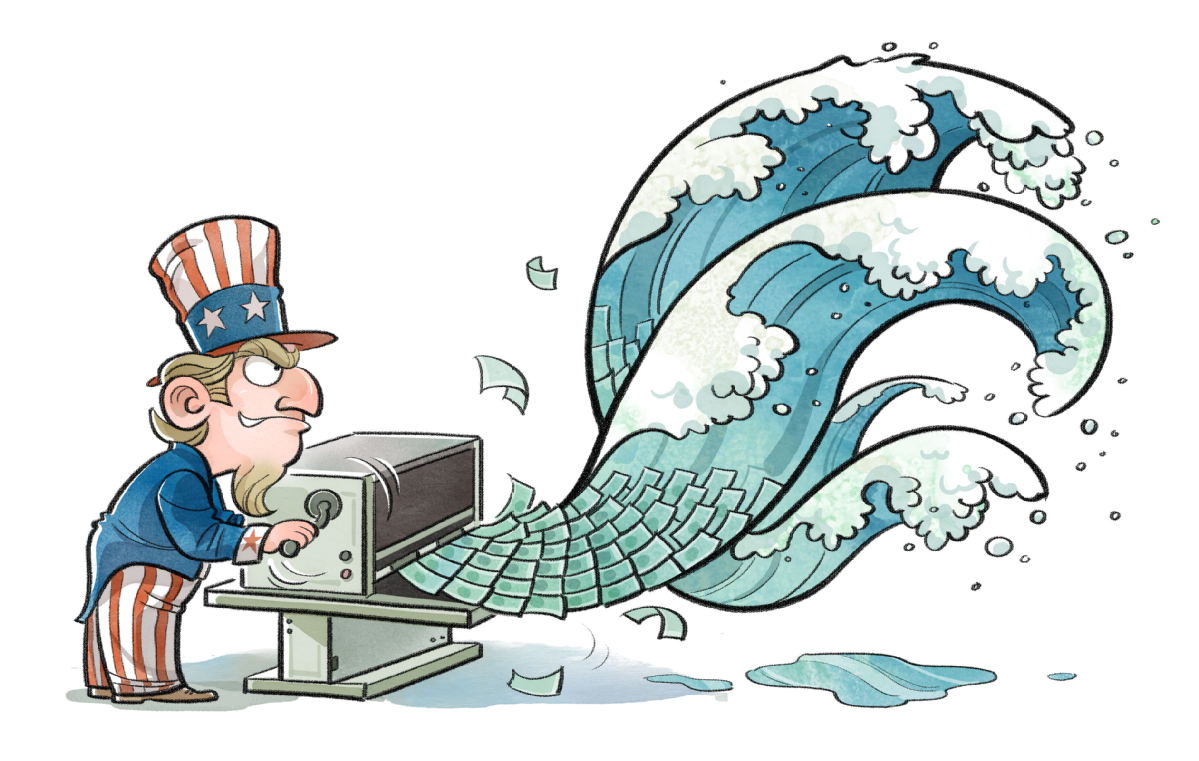Spamming of US dollar will hurt emerging markets
By Da Hsuan Feng/Haiming Liang | China Daily | Updated: 2021-03-27 07:43

The COVID-19 pandemic has jolted the global economy, including the US economy. Indeed, the collateral rapid economic recession has made it extraordinarily difficult to ascertain the risk on US corporations and the inability of people to pay all the debt which they will incur. This is a profound challenge facing the Joe Biden administration.
News came that the White House is weighing another stimulus package of $3 trillion, though the final decision has not been made yet.
Indeed, on March 11, just 51 days after being sworn in as the 46th president of the United States, Biden signed the so-called "Relief Bill" worth $1.9 trillion. According to the Committee for a Responsible Federal Budget, the bill "contains a third round of stimulus checks, extension of enhanced unemployment benefits, additional tax credits for families and workers, funding for K-12 education, and support for state and local governments. Smaller, but significant, expenditures include funds for COVID testing and vaccines, grants to small businesses, support for child care providers, assistance for colleges, and rental and homelessness assistance".
Infusion of huge amounts of dollars
It is not difficult to see the infusion of such a huge amount of "cash" into the market is de facto spamming of the US dollar, and it can only be paid for with "borrowed money". Such an action can and will increase the debt burden of the US government. And actually it has.
The US federal government printed $1.5 trillion worth of currency notes in 2000. In 2021, it will print $6.75 trillion worth of bills. Predictably, the market will experience a short-term "high".
Yet while basking in this "high", the country must realize it will be temporary prosperity, and will plant huge time bombs in the emerging markets, and one such market is China.
As mentioned earlier, the recent massive-scale monetary easing policy of the US Federal Reserve has officially transformed many of the former rescue measures for the financial system into people's basic livelihood.
This is the first time the US federal government has bypassed the usual intermediary role of commercial banks to directly or indirectly distribute life-saving financial aid among large and small enterprises and consumers. The Fed has taken on the role of a "lender of last resort".
To be fair, the Fed's rather robust measures aim to help companies deal with the pandemic-induced downturn and people with unemployment, relieve the concerns of investors about the collapses of the credit market, and prevent the onslaught of the US' financial market, even a global financial market tsunami. Perhaps such measures will help the US economy achieve a V-shaped recovery in the post-pandemic period. They can also provide an opportunity for the multinational companies in urgent need of a large infusion of US dollars to issue debt financing to protect themselves against the impacts of the pandemic.
Long-term impacts on emerging markets
But the Fed's measures can also have long-term impacts on emerging markets such as the Chinese mainland and Hong Kong.
First, by issuing excessive amounts of dollars, the US can and will further consolidate its global hegemony. Before 1971, every US dollar bill carried the words "Gold Coin", indicating the bill was backed by gold, and the holder of the bill could exchange it for gold. But during president Richard Nixon's administration in 1971, the US decided to terminate the bill-to-gold exchange system, and the words "Gold Coin" on US dollar bills were replaced with "Federal Reserve Note". In essence, such a "note" is simply an IOU(I owe you).
Still, the US dollar and its associated assets (such as US Treasury bonds) are the world's most important foreign exchange reserves and liquid financial assets. This means the global pension companies, insurance companies and financial institutions are either willing or forced to support the Fed's unlimited quantitative easing, or QE, policy. To do so, they must purchase more US dollars and US dollar assets.
Likewise, countries that are dependent on the US dollar as a medium of settlement as well as reserve currency are also worried that the excessive monetary easing policy could substantially weaken their own currencies. Therefore, to stabilize their domestic market, such countries also need to help the expansion of US dollars with the Fed (this is what is technically defined as the Swap Line) in order to obtain or maintain large and steady supply of the US dollars.
Dollar swap agreement
It was during the 2008 global financial crisis that the central banks of the European Union, Canada, the United Kingdom, Switzerland and Japan reached a temporary dollar swap agreement with the Fed. According to the agreement, the Fed will give these five central banks preferential treatment. Indeed, such a supply of US dollars to foreign central banks is equivalent to acknowledging the unique status of the US dollar in the international financial market and a way to solve the short-term shortage of US dollars in foreign banks during financial crises.
Although not intended, the temporary swap agreements have now become permanent. This means the only source of international currency flow now is the Fed. With this, the US is able to function as the global "lender of last resort". In this manner, the Fed's unlimited QE policy not only marginalized the euro, the British pound, the Japanese yen and other international currencies, it also lengthened the process of internationalization of emerging countries' currencies such as the Chinese yuan.
Second, the excessive issuance of US dollars could cause turbulence in the emerging markets. In the past, financial institutions used various indicators to ascertain the risks of and pressures on the financial market, including the Chicago Board Options Exchange volatility index, forward interest rate agreements, and overnight interest rate exchange spreads.
However, given the Fed's unlimited QE policy now, it is easier to determine whether the market turbulence has subsided simply by observing the appreciation and depreciation of the US dollar. After all, the volatility of the US dollar can create great turbulence in the global market.
For example, amid the COVID-19 pandemic, the Fed's unlimited QE measures have spread panic among investors. When such panic is coupled with a shortage of market liquidity, the natural reaction of companies, central banks and investors around the world will be to hoard more and more US dollars, and use US dollar-denominated assets as collateral. As for assets of other countries, including those of emerging markets, they will be sold off.
Key indicator of risks in the banking system
As a result, this not only can cause the dollar financing cost to soar to record highs, it also can make the appreciation and depreciation of the dollar a "mirror" reflecting the health of the global market-even a key indicator of risks in the banking system.
Perhaps the best way to determine the stability of the global financial system is to monitor the movement of the US dollar index. During the global financial crisis in 2008, the US dollar index was at its lowest at 70.7. If the US dollar index were to rise above 96, the global economic and financial outlook would be regarded as not very optimistic, prompting international investors to dump a large number of assets in the emerging and developing markets, and purchase the stable US dollar assets for the sake of hedging.
But if the US dollar index drops below 96, it means the global economy and financial markets are improving. The funds that had flowed into the US market will quickly flow back to the emerging markets in order to earn better returns. This will lead to a sharp drop in the cost of funds in the emerging markets. And the rise in asset prices can be seen as time bombs such as over-investment, overheating of the economy and inflationary pressures.
'Difficult to give up US dollar addiction'
The Fed's unlimited QE policy will thus make it progressively more difficult for international investors to give up their "US dollar addiction". This also means that in the future, the emerging markets will experience the cycle of "boom and bust".
And if the emerging markets were to continuously go through the "bubble and burst" cycle, their economies will suffer long-term "internal injuries" which would be difficult to heal-and they could become "emergency markets" instead of emerging markets in the future.
Third, by printing excessive amounts of dollar bills, the US will force a significant number of the global poor to support the rich in the US.
Unlimited QE measures will also aid US companies and people to stimulate consumption by taking large amounts of public and/or private loans, further deepening the pattern of "the US rich consume and the global poor produce".
Given the gloomy global economic outlook, the Fed's aggressive QE policy is in fact additional punishment for the emerging economies' currencies that are already shaky because of macroeconomics imbalances, withdrawal of foreign capital and/or political instability.
Asymmetric economic cooperation model
Thus, if these emerging countries want to obtain additional US dollars or US dollar assets as foreign exchange reserves in order to stabilize their domestic economies and currency exchange rates, they will have no option but to export more raw materials, household goods and industrial products to the US. Such an asymmetric economic cooperation model works to the benefit of the US simply because it can issue an unlimited number of banknotes irrespective of the accompanying rising deficit.
This means that in the future an increasing number of poor people around the world will have to work harder to provide more consumer and industrial goods for the wealthy Americans in order to obtain the US dollars.
It would be foolish to believe that the Fed's unlimited QE policy is aimed at rescuing the global market and guide the emerging markets to another round of economic cycle. As an old saying goes, "the market born in despair grows in half-belief, matures in longing, and is destroyed by false hope".
Indeed, when the market appears to be increasingly hopeful, it is precisely when global vigilance is called for.
Da Hsuan Feng is chief adviser, and Haiming Liang is chairman of the China Silk Road iValley Research Institute. The views don't necessarily reflect those of China Daily.
























